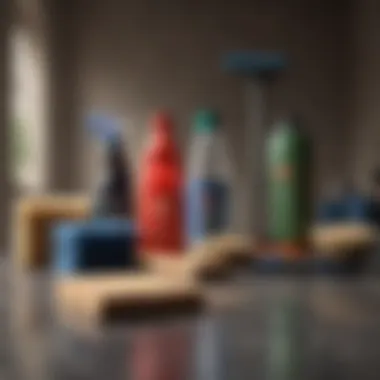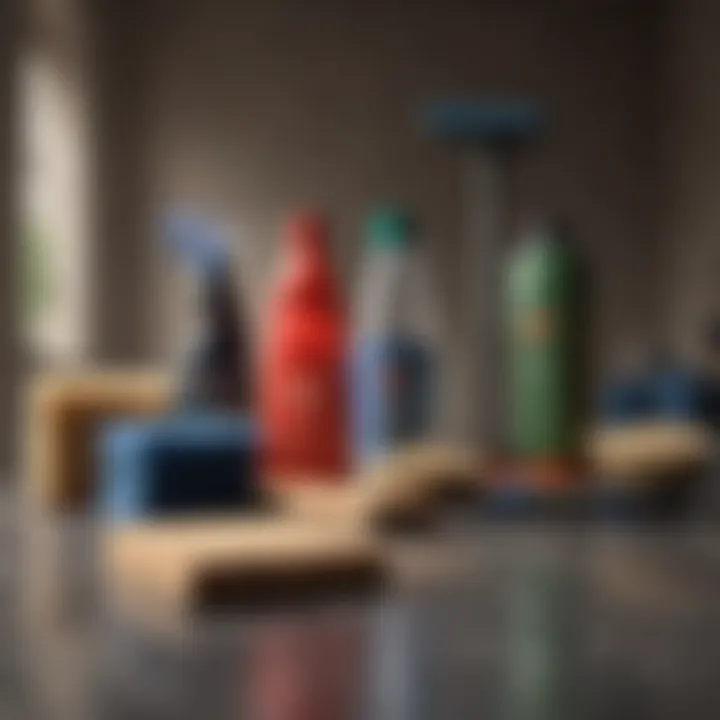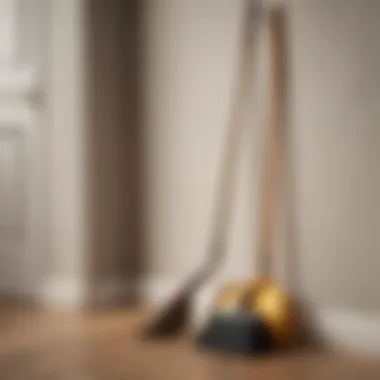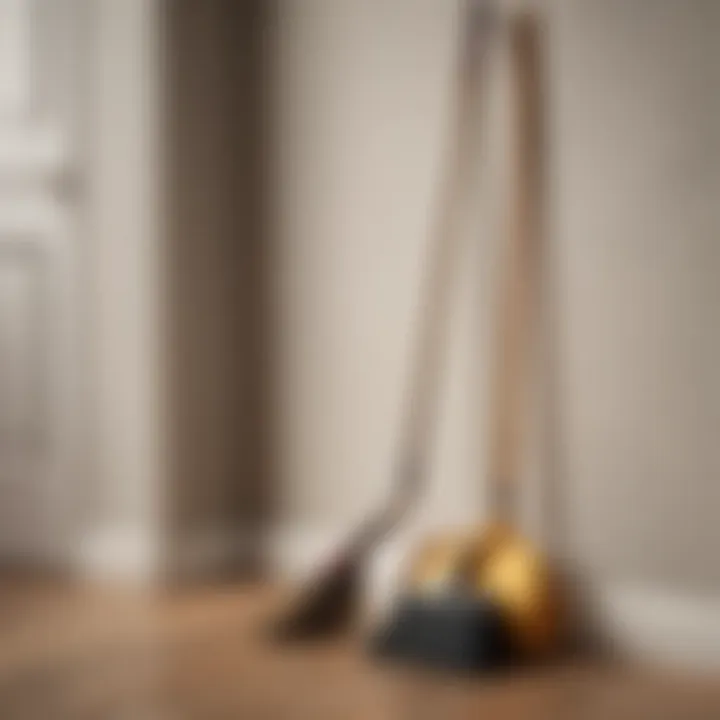Essential Household Cleaning Tools: A Comprehensive Guide


Intro
Cleaning tools are fundamental to maintaining a neat and efficient home. They not only contribute to hygiene but also enhance the overall aesthetics of living spaces. This guide aims to categorize and explain essential cleaning tools, offering insights on their specific functions, types, and care. Understanding the utility and upkeep of each tool can drastically improve cleaning routines, making them more effective and enjoyable.
Effective cleaning involves more than just scrubbing surfaces. It necessitates the right equipment that aligns with individual needs. From brooms to specialized vacuum cleaners, having the right tools at hand can save time and effort. Each cleaning tool offers unique advantages that can cater to various areas in the home.
Home Design Inspiration
When considering cleaning tools, it is important to integrate them into your home's design and aesthetic. Well-chosen cleaning equipment can seamlessly blend in with decor, enhancing both functionality and visual appeal.
Architectural Styles
Different architectural styles may require specific cleaning tools to suit their unique features. Homes with wooden floors, for instance, may benefit from specialized floor mops and polishers. In contrast, contemporary spaces with tile or stone surfaces could require heavy-duty scrubbing brushes or steam cleaners.
- Minimalist Homes: Focus on multi-functional tools that require less storage space.
- Victorian Architecture: Emphasize elegant cleaning tools that match ornamental details.
Innovative Decor Trends
In today’s market, there is a trend towards cleaning tools that not only serve a purpose but also complement home decor. Brands are producing tools with sleek designs and stylish finishes. For instance, a designer broom may feature chic handles or ergonomic grips, making it a statement piece while performing a necessary function.
"The right cleaning tools can enhance both utility and the visual essence of your living space."
Key Cleaning Tools to Consider
Brooms and Dustpans
Brooms are a staple in any cleaning arsenal. Available in various types, each is tailored for different surfaces. The standard broom is effective for quick clean-up, while push brooms excel on larger areas.
- Types of Brooms:
- Soft Brooms: Ideal for indoors, they sweep dust without scattering.
- Hard Brooms: Best for outdoor use on rough surfaces.
Maintaining brooms is straightforward; simply shake them out after use and store them upright.
Mops
Mops come in an array of designs, including sponge, flat, and steam mops. Each type is suitable for specific floorings and scenarios. For example, steam mops are beneficial for disinfecting hard surfaces without chemicals.
- Sponge Mops: Good for small spills and light cleaning.
- Flat Mops: Ideal for larger floor areas, allowing easy access under furniture.
Regular cleaning and drying of mops will prolong their lifespan.
Vacuum Cleaners
A vacuum cleaner is an indispensable tool for modern households. They come in various forms, including upright, canister, and robotic vacuums. Each type serves specific needs, and modern versions incorporate advanced filtration systems, enhancing indoor air quality.
- Upright Vacuums: Often more powerful for extensive carpets.
- Robotic Vacuums: Suitable for convenience, they automate regular cleaning tasks.
Maintaining vacuum cleaners involves regular emptying of dust bins and replacement of filters as recommended by the manufacturer.
Specialty Cleaning Tools
In addition to the basics, specialty tools serve distinct purposes. For instance, window squeegees provide spotless glass surfaces, while scrub brushes tackle tough stains on various surfaces.
- Window Squeegees: Essential for streak-free windows.
- Scrub Brushes: Versatile for both indoor and outdoor use.
Cleaning tools are a significant part of any household. Understanding their importance in function and design can benefit both homeowners and real estate enthusiasts alike. Properly selecting and maintaining these tools helps ensure a tidy living environment.
Intro to Household Cleaning Tools
Cleaning tools are pivotal in maintaining a home’s hygiene and allure. Their significance cannot be understated. Proper tools facilitate effective cleaning, save time, and enhance the overall quality of living spaces. They cater to varied tasks, allowing homeowners to tackle everything from minor spills to deep cleans with ease. With the right instruments, cleaning can transition from a chore to a more manageable, even rewarding, part of home maintenance.
Importance of Cleaning Tools
Cleaning tools serve more than a functional role; they contribute to a healthier living environment. For instance, using high-quality vacuum cleaners can significantly reduce allergens, benefiting those with sensitivities. Effective cleaning tools also promote efficiency. A good mop can clean larger areas more quickly than a traditional one.
Moreover, tools designed with ergonomics in mind minimize physical strain, making home maintenance easier for individuals of all ages. Thus, having the right tools boosts not only cleanliness but also the wellbeing of the household.
Overview of Common Types
There is an extensive array of cleaning tools available, each designed for specific tasks. Familiarizing oneself with common types can nourish informed choices.
- Brooms and dustpans: These essentials are used for sweeping up dirt and debris on hard surfaces. Varieties such as angle brooms and push brooms cater to different needs, from outdoor sweeping to indoor cleaning.
- Mops: Alongside varying types, mops serve to clean floors efficiently. Options include string mops and microfiber mops, providing versatility in cleaning methods across different surfaces.
- Vacuum Cleaners: Available in various models, including upright, canister, and robotic, they represent a central technology in modern cleaning. Their powerful suction capabilities can make a significant difference in floor cleanliness.
- Scrubbing Brushes and Sponges: These tools tackle grime in hard-to-clean areas, suitable for kitchens and bathrooms where tougher cleaning methods may be necessary.
In summary, understanding the types and characteristics of cleaning tools enables homeowners to select suitable products, making cleaning tasks more straightforward and effective.
Brooms and Dustpans


Brooms and dustpans serve as fundamental tools in household cleaning. They are essential for removing dirt and debris from various surfaces. In many households, these items are the first step before deeper cleaning. Their straightforward design belies their significance. An efficient broom and dustpan can make the difference in the ease of maintaining clean floors and surfaces. Understanding the different types of brooms and dustpans allows homeowners to select tools that align well with their cleaning routines.
Varieties of Brooms
Brooms come in several varieties, each designed for specific purposes. Below are some common types of brooms:
Regular Brooms
Regular brooms are the most common cleaning tools found in households. Their design allows for easy sweeping of indoor spaces. A key characteristic of regular brooms is their stiff bristles, which effectively capture dust and debris.
They are widely appreciated for their versatility. Regular brooms can be used on various flooring surfaces, such as tile, wood, and laminate.
One unique feature of these brooms is the size of their head, usually broad, to cover more ground in less time. In terms of disadvantages, regular brooms may not reach into corners easily, leading to the need for additional tools.
Push Brooms
Push brooms feature a wider head than regular brooms. Their main use is to clean larger areas more quickly. The bristles are often more substantial, designed to handle tough debris.
They are ideal for outdoor spaces like patios and garages, as well as large indoor areas such as warehouses or gymnasiums.
A distinct advantage of push brooms is their ability to move more dirt efficiently. However, they may not work as effectively in tight spaces, which can limit their utility in smaller homes.
Angle Brooms
Angle brooms are specifically designed for reaching into corners and tight spots. The bristles are cut at an angle, allowing for better maneuverability compared to regular brooms.
Their key characteristic is adaptability, making them beneficial for cleaning around furniture and baseboards. This ability to reach places regular brooms cannot is a significant advantage. However, angle brooms may not be as effective for sweeping larger areas due to their smaller head size.
Choosing the Right Dustpan
Selecting the right dustpan can significantly enhance the cleaning process. Dustpans come in a variety of shapes, sizes, and materials. The ideal dustpan should fit well with the broom being used. A common consideration is whether to choose a traditional flat dustpan or one with a lip.
Lip designs can help contain dust and debris better, reducing the chances of spillover. Additionally, choose a dustpan with a comfortable handle to make the cleaning process easier on the hands. Ultimately, choosing a dustpan that complements the broom ensures a smoother and more efficient cleaning experience.
Mops and Cleaning Solutions
Mops and cleaning solutions play a critical role in maintaining cleanliness in homes. These tools are designed to handle various floor types and messes. An effective mop paired with a suitable cleaning solution can elevate the cleaning experience, ensuring that surfaces are not only clean but also safe for daily use. With the right choices, homeowners can achieve better results in less time, making these tools essential for any cleaning routine.
Types of Mops
String Mops
String mops are a traditional choice for many people. They consist of multiple threads or strands that can absorb significant amounts of liquid. This characteristic makes them suitable for large areas or heavy spills. One of the main advantages of string mops is their ability to reach corners and edges, ensuring a thorough clean.
However, one should consider the maintenance of string mops. They can become dirty and may require frequent washing. The cleaning process can sometimes be messy as well. Nevertheless, many still prefer string mops because they are often less expensive compared to other types.
Sponge Mops
Sponge mops are another popular choice for households. Their key characteristic lies in the sponge base, which offers excellent absorbency. Sponge mops excel in cleaning up smaller spills quickly and efficiently. They are often easier to wring out than string mops, which can be a convenience factor for many users.
While sponge mops are effective, they can harbor bacteria if not cleaned properly after use. This is a significant disadvantage that some homeowners face. Regular cleaning is essential to maximize hygiene when using sponge mops.
Flat Mops
Flat mops have gained popularity in recent years due to their user-friendly design. They often feature a rectangular shape that allows for greater surface coverage. The flat design makes it easier to maneuver around furniture and tight spots, which can be a major benefit in busy households. Many users appreciate the ability to attach washable pads, which can be replaced as needed.
On the downside, flat mops may not handle heavy-duty cleaning as well as string mops. They are best suited for light cleaning and maintenance. Users may need to consider the type of cleaning needed before opting for flat mops.
Traditional vs. Microfiber Mops
When discussing mops, it is important to mention the difference between traditional mops and microfiber mops. Traditional mops, such as string mops or sponge mops, are effective for basic cleaning tasks. However, microfiber mops are designed for more efficient cleaning.
Microfiber mops can trap dirt and grime more effectively, often requiring less cleaning solution. This is a key benefit for environmentally conscious individuals seeking to reduce chemical usage. The materials also tend to last longer, providing cost-effective solutions over time.
Vacuum Cleaners
Vacuum cleaners play a crucial role in modern household cleaning. Their significance stems from their ability to efficiently remove dirt, dust, and allergens from a variety of surfaces. In homes where cleanliness is essential, vacuum cleaners not only save time but also contribute to healthier living environments. When considering cleaning tools, understanding the various types of vacuum cleaners and their functionality is important for making informed decisions.
Types of Vacuum Cleaners
Upright Vacuums
Upright vacuums are well-known for their convenience and power. They generally feature a large dust receptacle and strong suction capabilities. Their vertical design allows users to cover large areas quickly. This type of vacuum is particularly beneficial for carpeted surfaces, as they often come with brush rolls that agitate fibers. A unique feature of upright vacuums is their adjustable height settings, making them versatile for various carpet types. However, they can be heavy and cumbersome for some users, particularly when maneuvering around furniture.
Canister Vacuums


Canister vacuums offer a different experience. They consist of a separate canister body connected to a long wand. This design allows for more flexibility and reaches into tight spaces that upright vacuums may struggle with. Canister vacuums are typically lightweight, making them easier to carry up and down stairs. They are also effective on hard floors and low-pile carpets due to their suction design. One drawback is that they might require a bit more storage space because of the separate components, which can be a consideration for those with limited storage.
Robotic Vacuums
Robotic vacuums represent a more recent advancement in cleaning technology. These smart devices are designed to autonomously navigate and clean floors without human intervention. A key characteristic of robotic vacuums is their ability to remember the layout of a home, optimizing their cleaning efficiency. They are particularly beneficial for busy individuals, as they can operate while one is away. However, their suction power might not match that of traditional vacuums, especially when dealing with larger debris.
Selecting the Right Vacuum for Your Home
Choosing the right vacuum cleaner depends on various factors such as floor type, household size, and personal cleaning preferences. Here are some considerations:
- Floor Types: Assess if your home has mostly carpets, hardwood floors, or a mix. Upright vacuums excel on carpets, while canister vacuums are preferable for hard flooring.
- Size and Storage: Take into account the space available for storage. Robotic vacuums save space but ensure they meet cleaning needs.
- Allergies: If anyone in your household suffers from allergies, look for vacuums with HEPA filters to trap allergens effectively.
With these points in mind, selecting the right vacuum cleaner becomes a strategic decision that contributes to maintaining a clean and healthy home.
Cleaning Cloths and Rags
Cleaning cloths and rags play a vital role in maintaining cleanliness and hygiene in households. They are essential for various tasks, from wiping surfaces to soaking up spills. Different types of cloths serve unique functions, providing the flexibility to tackle diverse cleaning needs effectively.
Types and Materials
Microfiber Cloths
Microfiber cloths are a preferred choice for many because of their superior cleaning capabilities. The unique weave of the microfiber enhances its ability to trap dirt, dust, and allergens more effectively than standard cloths. Their structure allows them to absorb moisture while leaving surfaces streak-free.
Moreover, microfiber cloths are generally durable and can withstand multiple washes without losing effectiveness. This makes them eco-friendly, as homeowners can reduce waste. Despite these benefits, some may find them slightly more expensive initially compared to traditional options, but the long-term savings in replacements often justify the investment.
Cotton Rags
Cotton rags offer a more traditional approach to cleaning. They are often used for a variety of tasks, from dusting to drying dishes. One notable feature of cotton rags is their absorbency, making them effective at soaking up spills quickly. Additionally, they are relatively inexpensive and readily available.
A drawback, however, is that cotton rags may not pick up dust and allergens as efficiently as microfiber. They also tend to be less durable and can disintegrate after many uses. Nonetheless, their versatility and comfort make them a familiar choice in many homes.
Disposable Wipes
Disposable wipes provide convenience that some find indispensable. These pre-moistened cloths offer a quick and efficient cleaning solution for unexpected messes. Their key characteristic is their one-time use, ensuring a clean cloth for each application, which can reduce the spread of bacteria.
However, disposable wipes have their downsides. They contribute to environmental waste and can become costly if used frequently. They also may contain chemicals that some users might prefer to avoid. Nevertheless, for those seeking fast solutions, disposable wipes remain a valuable addition to cleaning supplies.
Best Practices for Use and Care
To maximize the effectiveness of cleaning cloths and rags, it is important to follow some best practices:
- Wash regularly: Cleaning cloths should be laundered frequently to remove dirt and bacteria. Microfiber should be washed without fabric softeners to maintain its properties.
- Store properly: Keep cloths in clean, dry areas to prevent contamination.
- Use appropriate types: Choose the right cloth based on the cleaning task to enhance efficiency.
By understanding the various types of cleaning cloths and their best practices, homeowners can make informed decisions that align with their cleaning needs and preferences.
Scrub Brushes
Scrub brushes are essential tools in any cleaning arsenal. Their design allows for effective scrubbing of various surfaces. Whether tackling dirt on floors, tiles, or countertops, the right scrub brush can make a significant impact. They are particularly valued for their ability to remove tough stains and grime that other cleaning tools might leave behind.
The materials used in scrub brushes play a vital role. Different bristle types serve varied purposes. Understanding these differences ensures that one selects a brush suitable for specific cleaning tasks. Furthermore, incorporating scrub brushes into a cleaning routine can lead to improved hygiene in a home, ultimately contributing to a healthier living environment.
Choosing the Right Brush
When choosing a scrub brush, factors such as bristle stiffness and handle length should be taken into consideration. Brushes with stiff bristles are ideal for tough scrubbing tasks, such as removing stubborn stains from floors or decking. Conversely, softer bristles are more suitable for delicate surfaces, preventing scratches and damage.
Another consideration is the ergonomic design of the brush. A well-designed handle provides comfort, especially during extended cleaning sessions. Look for brushes with non-slip grips to enhance control and efficiency during use.
In summary, the right selection of a scrub brush can vastly improve cleaning outcomes.
Uses of Scrub Brushes in Cleaning
Scrub brushes have versatile applications in household cleaning. They can be used in various settings:
- Bathroom Cleaning: Effective in scrubbing tiles, sinks, and bathtubs, helping to remove soap scum and mildew.
- Kitchen Cleaning: Useful for scrubbing pots, pans, and surfaces, ensuring that tough food residues are addressed.
- Outdoor Spaces: Great for cleaning patios, decks, and outdoor furniture, as they can handle dirt and moss that accumulate over time.
"Using the correct scrub brush not only improves cleaning efficiency but also reduces the time spent on each task."
Incorporating scrub brushes into a cleaning routine can lead to noticeable improvements in cleanliness and maintenance of various surfaces. Regular use ensures that grime does not accumulate, which is beneficial in the long run.
Sponges and Scrubbing Pads
Sponges and scrubbing pads are critical components of household cleaning. They offer versatility in cleaning a variety of surfaces due to their different textures and absorbency. These tools are not just about removing dirt; they also play a role in maintaining hygiene by eliminating germs and bacteria. Understanding the types of sponges available can help homeowners choose the most effective tool for their cleaning needs.
Types of Sponges


Cellulose Sponges
Cellulose sponges are popular cleaning tools made from natural wood fibers. They are highly absorbent, capable of soaking up considerable amounts of liquid. This makes them excellent for wiping surfaces, cleaning dishes, or mopping up spills. The key characteristic of cellulose sponges is their biodegradability, which makes them an eco-friendly choice. However, they can harbor bacteria if not cleaned properly. Regular rinsing is essential to ensure they remain hygienic. The advantage of cellulose sponges lies in their ability to rinse clean easily compared to synthetic sponges.
Konjac Sponges
Konjac sponges originate from the konjac plant and are known for being soft and gentle. They are mainly used in skincare but have also found a place in household cleaning. Their key characteristic is that they are natural and free of additives, making them safe for various surfaces. They are beneficial for sensitive skin, thus good for cleaning delicate items. The unique feature of konjac sponges is that they become quite soft when wet, allowing for gentle cleaning without scratching. However, their lifespan is shorter compared to other sponges, necessitating regular replacement.
Scouring Pads
Scouring pads are tough cleaning tools designed to tackle stubborn stains and grime. The key characteristic of scouring pads is their abrasive surface, making them effective for scrubbing pots, pans, and other hard surfaces. They are a popular choice due to their effectiveness in removing burnt-on food and tough stains. One unique feature is their dual-sided construction; one side is usually course for scrubbing, while the other can be softer for polishing. However, they can scratch certain surfaces, such as non-stick coatings or glass, so care must be taken when using them. Their durability varies based on the material, so choosing quality pads is crucial for optimal performance.
When to Replace Sponges
Knowing when to replace sponges is essential for maintaining a clean home. Sponges should be replaced every few weeks, depending on usage. Look for signs such as bad odor, discoloration, or visible wear. These are indicators that the sponge has reached the end of its lifespan. Using worn sponges can be counterproductive to cleaning efforts and might even spread germs instead of removing them. Regular replacement ensures effective cleaning and hygiene.
Safety and Eco-friendly Cleaning Tools
In recent years, the demand for safety and eco-friendly cleaning tools has intensified. This shift stems from a growing awareness of the potential hazards associated with conventional cleaning products and the impact these products have on the environment. The inclusion of these tools in your household cleaning routine is not just a matter of preference; it is essential for both health and sustainability. Homeowners are increasingly interested in maintaining a safe living environment while minimizing their ecological footprint. Having knowledge about safety features and eco-friendly options allows users to make informed decisions that benefit their homes and the planet.
Benefits of Eco-friendly Tools
Opting for eco-friendly cleaning tools brings several distinct advantages:
- Healthier Indoor Air Quality: Many conventional cleaning agents emit volatile organic compounds (VOCs), leading to air pollution inside the home. Eco-friendly options typically have lower VOCs, resulting in better air quality.
- Safety for Children and Pets: Households with children or pets require special consideration. Eco-friendly products often avoid harmful chemicals that can pose risks, making them safer for everyone in the home.
- Sustainable Practices: Products made with biodegradable materials contribute to environmental sustainability. They break down naturally and are less likely to pollute landfills or water supplies.
- Effectiveness: Surprisingly, eco-friendly cleaning tools can be just as effective, if not more so, than their traditional counterparts. Many of them employ natural ingredients that break down dirt and grime effectively.
Because of these considerations, it is essential to explore options like non-toxic cleaners, reusable cloths, and sustainable scrub brushes. Choosing these tools not only promotes a clean home but also fosters planetary health.
Common Safety Considerations
When selecting cleaning tools, certain safety considerations are vital to ensure effectiveness with minimal risk:
- Chemical Exposure: Always read labels carefully. Many cleaning products can contain hazardous ingredients that may not be suitable for all surfaces or environments.
- Proper Protection: If a product recommends wearing gloves or a mask, it is crucial to follow these guidelines. Even eco-friendly products can cause irritation if used improperly.
- Storage Safety: Store cleaning tools and solutions out of reach of children and pets. Even non-toxic products can pose risks if ingested or misused.
- Disposal Practices: Know how to dispose of cleaning tools properly. Eco-friendly tools often come with specific disposal guidelines, ensuring that their end-of-life does not harm the earth.
"Using safe cleaning products not only protects you but also contributes to a healthier world."
By prioritizing safety and environmental responsibility, individuals can maintain clean and safe homes. They still achieve high functionality in their cleaning routines, demonstrating care for both their health and the planet.
Storage and Organization of Cleaning Tools
Effective storage and organization of cleaning tools is crucial for any home. It improves efficiency and ensures that cleaning routines are conducted smoothly without interruptions. Having a well-organized cleaning area saves time by allowing users to find tools easily. Moreover, it enhances the overall aesthetic appeal of the space, making it look tidier. Proper organization can also prolong the life of cleaning tools, as they are less likely to be damaged or misplaced. In a world where cleanliness is often equated with order, the need for careful management of cleaning supplies cannot be overstated.
Optimal Storage Solutions
When it comes to storing cleaning tools, there are various solutions to consider. Proper storage not only prevents clutter but also makes tools readily accessible.
- Cabinets: Undercounter cabinets can provide hidden storage for cleaning supplies. They prevent dust accumulation and keep tools out of sight, which is visually appealing.
- Shelves: Open shelving units allow for easy access to everyday cleaning tools. Organizing them by category, such as mops, brooms, and cloths, can enhance visibility.
- Hooks and Racks: Wall-mounted hooks are ideal for hanging brooms and mops. This method saves space and ensures that these tools are readily available.
- Carts: A rolling cart can be useful for organizing cleaning supplies in one mobile unit. It allows easy transport around the house and can be tucked away when not in use.
- Storage Bins: Clear bins help to group similar items together. Labeling these bins can enable quick identification while maintaining order.
Whichever method chosen, it is important to consider regularly used items and how often they need to be accessed.
Tips for Maintaining an Organized Cleaning Space
To sustain an organized cleaning space, a few simple strategies can be very effective:
- Regular Decluttering: Schedule a time each month to assess the cleaning tools. Dispose of or recycle items that are no longer usable or necessary.
- Consistent Cleaning Routine: After each cleaning session, put tools back in their designated storage space. Cultivating this habit is key to maintaining organization.
- Easy Access: Keep frequently used tools at eye level. This makes them accessible and encourages adherence to the organization system.
- Adapt Storage Based on Use: If a tool is used less frequently, it can be stored higher up or in less accessible areas. This frees up valuable space for daily essentials.
- Label Everything: Labels act as constant reminders and make it easier for everyone in the household to maintain the organization.
To sum up, a dedicated approach to storing and organizing cleaning tools not only contributes to a more efficient cleaning process but also enriches the overall experience of maintaining a clean home. By employing thoughtful storage solutions and consistently applying organization strategies, anyone can cultivate a space that is both functional and inviting.
Maintenance of Cleaning Tools
Proper maintenance of cleaning tools is crucial for ensuring efficiency and longevity. When tools are well-maintained, they not only perform better but also contribute to a cleaner and healthier environment. This segment aims to inform homeowners and cleaning enthusiasts about the key practices involved in maintaining cleaning tools and their benefits.
Keeping cleaning tools in optimal condition prevents the buildup of dirt and grime, which can impact their performance. For example, if a vacuum cleaner is not regularly cleaned, its suction power diminishes, leading to incomplete cleaning tasks. Additionally, a clean tool reduces the risk of spreading dirt and allergens throughout the home.
Regular Cleaning of Tools
Regular cleaning of tools is essential, as it directly relates to their effectiveness. Different tools require different cleaning methods, but some general guidelines apply:
- Brooms and Dustpans: Shake out or sweep away debris regularly. Wash dustpans after use to prevent residue buildup.
- Mops: Rinse mops thoroughly after each use and allow them to dry completely. This prevents the growth of mold and odors.
- Sponges: Regularly replace or wash sponges. Many sponges can be disinfected in the microwave or dishwasher.
- Vacuum Cleaners: Empty dust canisters or change filters as necessary to maintain suction power.
By implementing these practices, homeowners can ensure their cleaning tools remain effective and hygienic.
Extending the Lifespan of Your Tools
Extending the lifespan of cleaning tools involves more than just keeping them clean. Here are several effective strategies:
- Proper Storage: Store tools in a dry area, ideally hanging to prevent damage. Avoid leaving them in direct sunlight which can lead to wear.
- Follow Manufacturer's Instructions: Each tool often comes with specific care recommendations. Following these guidelines can prevent damage and ensure optimal use.
- Handle with Care: Using tools as they are meant to be used ensures they do not break or wear down unexpectedly. For instance, using a scrub brush for scrubbing surfaces, not as a scraper, can keep it in better shape.
By incorporating these maintenance practices, individuals can not only improve the functionality of their cleaning tools but also save money by delaying the need for replacements. Investing time in maintenance pays off in quality cleaning and tool longevity.
"Maintaining your cleaning tools can ensure your home remains clean and supports a more efficient cleaning routine, ultimately enhancing your living space."







